#guthrum of east anglia
Text

Silver Coin from Winchester, England dated between 875 - 885 on display at Winchester Catherdral, England
This coin was excavated in the Cathedral Close and bears the head of Alfred the Great with the inscription +ÆLFREDREXSA+ which translates to Alfred, King of the Saxons. From 871 to 886 Alfred was King of the West Saxons, the Kingdom of Wessex. During this time of Alfred's reign the Vikings under Guthrum, later King of East Anglia (879 - 890?), Ivar the Boneless, Halfdan Ragnarson, Ubba and Bagsecg formed the Great Heathen Army and invaded much of England.
Photographs taken by myself 2023
#art#archaeology#history#england#english#medieval#9th century#winchester cathedral#museum#winchester#barbucomedie
118 notes
·
View notes
Text
My love for Soma continues to grow beyond what’s reasonable for a cluster of pixels, and it’s always Birna’s tales that catalyse it:
❝ Soma of Grantebridge. For a time, all the ealdormen of England wanted her dead. A bounty on her head the size of Yggdrasil.
She met with the leader of the South Gyrwans and told their King Roffe, “Say that you killed me. Proclaim it to all the lands.”
Roffe answered, “No one will believe me.” And Soma shook her head.
“Invite them. Here. You will burn me on a pyre for all to see.”
So they came, the nobles of East Anglia, north and south, of Mercia, of Wessex. They wished to see Guthrum’s Valkyrie die. Before all, King Roffe pronounced her guilty of murder and sentenced her to death. Then they put her on a boat and sit it afire.
Yet Soma had constructed a trap beneath the pyre. She released herself into the murky waters and swam to a bramble. Muddied and wet, she waited in the thorns for night to fall. She then returned to Cambridge as a shadow-walker.
She entered the city and stole into the king’s chamber, and took the head of Roffe, shouting, “Traitors of Soma wear no heads!”
The Saxons thought Soma a ghost! A spirit who kills! A curse invincible to fire and death! What a leader, my Soma. ❞
Like holy shit she’s so intelligent and can be downright feral. People literally thought she was inhuman for a time?? She was known as Guthrum’s Valkyrie - a literal harbinger of death - before that? And Wigmund really thought it was a smart idea to try and conquer that??? I love her.
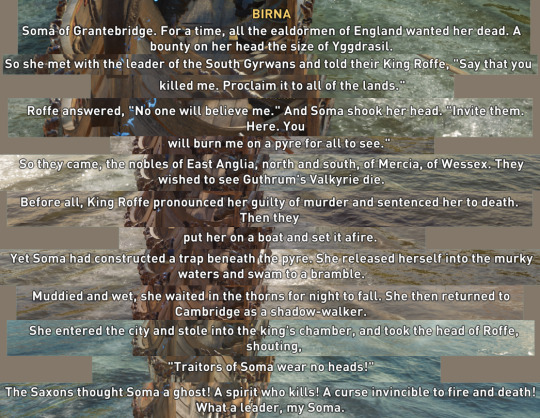
Here’s a shitty splice of the story in-game. Under the cut to hide its ugliness.
#the things i would let that woman do to me#guthrum's fucking valkyrie#soma jarlskona#lord of grantebridge
84 notes
·
View notes
Quote
It has been argued that the geographic location of many of the Shuck areas means that the folklore of this Dog and its associated demeanour of being more evil than many of the other types of Black Dog is due to settlement by the Scandinavians. The premise is that the virulence of the Vikings is responsible for much of the legendary aspects of the Shuck. Danes invaded in AD 869 and murdered the Angle king Edmund, proceeding to destroy the Angle monasteries. In 1014 Guthrum was appointed Norse king in East Anglia and it has been suggested that there is relevance in the fact that his nickname was "The Great Black Dog of Langport."
Mark Norman, Black Dog Folklore
7 notes
·
View notes
Text
Since Ubisoft refuses to confirm what happened to Oswald and Valdis since Guthrum became King of East Anglia, I have accepted that Valdis is a shield maiden for Eivor and comes home after every raid to her malewife, Oswald.
6 notes
·
View notes
Text
Halfdan was one of the leaders of the Viking Great Army of the 9th-Century; one of his brothers was Ivar (usually identified with the “Ivar the Boneless” of the sagas).
The 'Great Heathen Army' arrived in England in autumn 865, and killed the kings of Northumbria and of East Anglia in the next four years.
In the autumn or early winter of 870, Halfdan and his warband left East Anglia and invaded the kingdom of Wessex, establishing their base at Reading.
The Anglo-Saxon Chronicle - which for this period is a near contemporary source - gives a detailed narrative of the campaign that followed: the vikings fought nine general engagements against the West Saxons who were led by their king, Æthelred I and his brother - and successor - Alfred.
The most important of these battles took place on the Berkshire Downs, at the place called Ashdown, in January 871.
The viking army was drawn up in two divisions: one, opposed by Alfred, was led by various jarls; the other, which King Æthelred engaged, was under the command of 'the heathen kings Bagsecg and Halfdan'.
Ashdown was a West Saxon victory, but it was only one in a series of battles that winter. The two sides were at stalemate, despite the arrival of a 'great summer army’ to reinforce Halfdan’s host.
In the autumn of 871, the combined viking army left Reading and wintered in London. By now, Alfred was king of Wessex. The Army went on to campaign again in Northumbria - drawn there by a revolt against its puppet king - before it settled for the winter in Mercia at Torksey (on the River Trent; this winter camp has yielded a lot of archaeological finds).
The vikings remained there for a year; late in 873 they moved on Repton (which has also yielded archeological finds) and drove the Mercian king, Burgred from his kingdom.
The following year the viking army divided into two. While Guthrum occupied Cambridge - from where he invaded Wessex once more - Halfdan took his contingent north to a base on the Tyne. They attacked the Picts and Strathclyde Britons and then returned south to settle Northumbria where they “proceeded to plough and to support themselves” (Anglo-Saxon Chronicle, 876).
Halfdan’s men occupied the area centred on York; the northern part of Northumbria remained in the hands of the English lords of Bamburgh.
Halfdan himself does not seem to have joined his followers in settling what eventually became Yorkshire. He may have gone to Ireland instead. His brother Ivar had died there in 873, and Halfdan may have attempted to take his brother’s place as ‘king of the Northmen in Ireland and Britain’.
Certainly, the Annals of Ulster record a bout of Viking bloodletting in 875, when ‘Albann’ (i.e., Halfdan) killed a rival’s son.
Halfdan was certainly in Ireland in 877, when the Annals of Ulster record another skirmish at Strangford Lough between rival Scandinavian leaders; only this time, it’s Halfdan, “the king of the Danes” who died on the day.
Image by Michael Rosskothen.

1 note
·
View note
Text
26th October
Alfred the Great
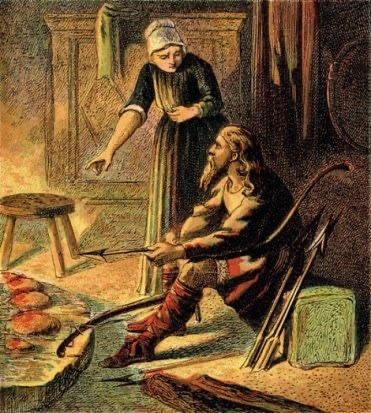
Source: Historic U.K. website
On this day in 899 AD, Alfred the Great died. Rarely has the epithet “The Great” been more deserved. This extraordinary early medieval King of Wessex was unseated from his throne by a Viking invasion and forced to hide out in the boggy fens of the island of Athelney. But from here, Alfred launched a guerrilla war against Guthrum, the Danish usurper, and emerged eventually to defeat decisively the Danes at the battle of Edington. After requiring Guthrum to convert to Christianity and packing him and his men off to rule East Anglia, Alfred got to work. He developed a system of strategically placed forts called burghs to thwart future Viking attacks; he developed a navy; he promoted literacy in his court; he commissioned the Anglo-Saxon Chronicle; he supported the Church and he revised the mess that were the existing Germanic legal traditions into something resembling an English legal code.
It is extraordinary then that today Alfred is chiefly remembered for letting a set of cakes burn. Allegedly, while still hiding out from the Danes in Athelney, the despondent king was staying in a peasant’s home and promised the lady of the house he would watch her baking cakes while she completed an errrand. Lost in thought, he forgot about the cakes and the horrified woman returned to fund them burned to a cinder. Despite royal apologies, the enraged housewife supposedly scolded and beat Alfred for ruining their supper, king or no king. Quite what this almost certainly invented tale is supposed to represent is anyone’s guess, unless it be the general uselessness of men in the home.
#alfred the great#Athelney#Alfred burns the cakes#battle of edington#Guthrum#Viking invasions#wessex#Anglo Saxon chronicle
0 notes
Text

Alfred of Wessex negotiating the Treaty of Alfred and Guthrum and establishing the Danelaw, circa 880
35 notes
·
View notes
Note
Can I get you to infodump about the danelaw because I literally only know about it from crusader kings 3 and much as I love paradox idk how well history gets distilled into a management game
Kthx have a good day
this took me so long to get to APOLOGIES
i've kind of cherry-picked important and interesting bits without writing a whole book or something so here goes lol
first off its important to note that the Danelaw in and of itself was a VERY brief spit of time which was also constantly in flux !! it lasted less than 100 years sandwiched between the start of the Norse invasions and the ousting of a king (and his death), then it was only another 100 years until the Norman invasion, it was a Wild time
ALSO i'll mention too that the term "Danelaw" was probably not a contemporary term. It's first recorded mention as Dena lage in the 11th century, over 50 years after what's now considered the Danelaw had dissolved. It's a term used to distinguish the self-governed Norse-held areas of Britain from those under West Saxon or Mercian law, literally The Danish Law and wasn't used to describe the geographic area until a little later.
It's also worth mentioning that while certain parts of the Danelaw were maintained as kingdoms or client kingdoms of some form (namely the Kingdoms of York and East Anglia), a whole lot of what was part of Mercia or Essex was left to its own devices under Jarldoms of the larger towns (boroughs/burhs). What was called The Five Boroughs of the Danelaw were a very important area in their own right, constituting a strong alliance between the Jarldoms of Derby, Leicester, Lincoln, Nottingham and Stamford. The area south of there was also under various Jarldoms (like Cambridge and Northampton) but they weren't as influential or closely knit as the Five. Technically speaking, the Danelaw is considered a Confederacy under the Kingdom of Denmark, but even aside from the existing peoples, the Norse people living there weren't all from Denmark by any stretch. After it's reunification under Alfred, the whole of England did become part of the Kingdom of Norway for a while under Cnut the Great, before his death split the various territories again, though England was still under Scandinavian influence of some degree all the way up to the Norman Conquest.
one of the more interesting things about the whole affair is that the culture and languages of the Scandinavian Norse and Anglo-Saxons were actually very similar as they had come from the same core groups of people not too long before. the speech was mutually intelligible at a basic level, both parties used a form of the Younger Futhark in some part, a lot of cultural concepts were the same. Aside from the Norse being an outside force, the only big difference was religion. The Saxon kingdoms had been entirely Christian for at least 100 years, despite the Saxons themselves being an interrupting force in the spread of Christianity through Britain even from during late Roman occupation.
Probably the EASIEST thing that made it all compatible other than the language was the similarity between the legal systems of the territories. For example the concept of compensatory damages existed in both places (weregild, literally man-gold), the Norse land division wapentake was more or less interchangeable with the Anglo-Saxon hundred, and so on. A lot of vague traditions held by Saxon peoples were continued in their own fashion, and other than the obvious upheavals of new rulers and raiding parties, not much else actually changed. The descendants of the united Scandinavian armies also made it a relatively peaceful area considering the remaining Anglo-Saxon kingdoms regarded them as squatters, but their closer shared culture and remaining unity actually made it pretty easy for the loose alliances of the Danelaw to stand up to the Anglo-Saxon pushback until it was mostly just Wessex left, with King Alfred in hiding somewhere in the Somerset marshes.
It's really quite astounding Alfred bounced back to unify England at all after that on the face of it.
the geographic spread is also an interesting thing ! the first recorded Viking raid is in 793 at Lindisfarne monastery off the coast of modern Northumberland (VERY north) but the first recorded wintering of Norse peoples intending to stay long-term was actually in East Anglia (VERY south). What the Anglo-Saxon Chronicles called "The Great Heathen Army" marched the length of England to go and take advantage of a civil war happening back in Northumbria, where they captured and sacked York (Angle: Eoforwic, Norse: Jórvík) in 865.
This established the START of the Danelaw as its usually measured, which spanned from 865 to 954.
It actually took only 10 years from the sacking of York for most of the Danelaw to become the Danelaw as most of its maps depict at its maximum, and for Alfred of Wessex to make peace with yet another settled Norse group in Dorset. Also! its worth noting that Alfred only became the king of Wessex after his brother Æthelred died in 871, well after the Dane forces had already taken hold of the Kingdom of York, the Kingdom of East Anglia, and a significant chunk of Mercia.
He was of course already involved in the affairs but he did get chucked in at the deep end lol
Part of the peace keeping the re-established Kingdom of Wessex under Alfred and the Danelaw at large under fairly steady and peaceful borders for its more stable periods (definitely a relative term) from 878 , was down to Guthram and Alfred's agreements. After Alfred came out of his hiding in exile with an army, and forced the Danes to surrender, Guthram agreed to be baptised with Alfred as his godfather, and also agreed to go back to his Kingdom in East Anglia. In 884 Guthram made a run of it again and attempted to take Kent, but in being unsuccessful he signed the Treaty of Alfred and Guthrum, which basically established the formal border of the Danelaw and let them self-rule if they did keep to themselves. It wasn't until 902 that shenanigans started happening again, but considering how generally tumultuous the entire period was, just shy of 20 years of formalised peace wasn't bad going.
Eiríkr Haraldsson (or Eric Bloodaxe) was a pretty obscure guy for a lot of his life considering he was definitely Norwegian nobility. It's thought he may have been King of Norway for a short time, and maybe Northumbria twice over - though definitely for the second time when he was ousted from Northumbria - which essentially brought the end of the Danelaw proper. He's mentioned in a LOT of texts (Egils / Orkney / Icelandic / Norwegian sagas, Anglo-Saxon Chronicle. potentially Historia Norwegiæ, Annals of the Four Masters, Annals of Clonmacnoise), but he's still a bit of a vague figure somehow. He's noted as being a son of Harald, and the Icelandic and Norwegian version of events is that he was one of Harald Fairhair's many sons, although some people think he may have been the son of Harald Bluetooth. He DID definitely exist though, the last Norse minted coins in York are stamped with his name. Norse Northumbria and York was very strongly tied to the Norse Kingdom of Dublin (which lasted a LONG time by comparison), but upon his being removed in 954 the hope of the lands becoming a two-part kingdom fell apart.
The end of the Viking Era itself is often cited as being the defeat of King Harald (Hardrada) Sigurdsson of Norway at the Battle of Stamford Bridge in 1066. He had landed hoping to retake York and the English crown as a whole with the help of King Harald Godwinson's brother Tostig, but the English forces managed to stop them. This actually probably helped out William the Conqueror (also of Norse decendant, Norseman - Norman) efforts less than a month later to take England, since the English armies had already dealt with the same thing and were mostly in the north away from the attacking forces from Normandy. Under William's Norman rule there were a few more attempts by other Scandinavian rulers to retake or at least plunder York, but the efforts never went very far. The last serious raids on England from Scandinavia came from Eystein II of Norway, who took advantage of The Anarchy (a civil war in Norman territories over a succession crisis between 1135 and 1153) to plunder the East Coast.
OKAY i'll stop waffling now but here we go jfkddfjdk
i hope this was interesting enough and something like what you were after instead of just some word puke gjfkdkjfd !!!
18 notes
·
View notes
Text
The Battle of Ashdown - Saxon Victory Over Viking Danes

By 870, the Vikings had conquered two of the four Anglo-Saxon kingdoms, Northumbria and East Anglia. At the end of 870 they launched an attempt to conquer Wessex and marched from East Anglia to Reading, arriving on about 28 December. Three days after their arrival they sent out a large foraging party, which was defeated by an army of local levies under the command of Æthelwulf, Ealdorman of Berkshire, at the Battle of Englefield, but only four days later the main West Saxon army under Æthelred and Alfred was defeated at the Battle of Reading.
Four days later, on about 8 January, the armies fought again at Ashdown. The Vikings arrived first at the battle ground and deployed along the top of the ridge, giving them the advantage. They divided their forces into two contingents, one under their kings, Bagsecg and Halfdan, the other under their earls. When the West Saxons heard this from their scouts, they decided to copy the formation, with Æthelred facing the kings and Alfred the earls. The king then retired to his tent to hear Mass, while Alfred led his forces to the battlefield. Both sides formed their forces into shield walls. Æthelred would not cut short his devotions and Alfred risked being outflanked and overwhelmed by the whole Danish army. He decided to attack and led his men in a charge up hill. Battle then raged around a small thorn tree and finally the West Saxons were victorious. Although both the Anglo-Saxon Chronicle and Asser emphasise Alfred's role in the victory, in the view of Richard Abels it was the attack by Æthelred when he joined the battle which was decisive and he may have intended all along to take the Vikings unawares. They suffered heavy losses, including King Bagsecg and five earls, Sidroc the Old, Sidroc the Younger, Osbern, Fræna, and Harold. The West Saxons pursued the fleeing Vikings until nightfall, cutting them down.
However, victory proved short-lived, as it was followed by two defeats, at Basing and Meretun. Soon after Easter, which fell on 15 April in that year, Æthelred died and was succeeded by Alfred who would eventually go on to drive the viking scourge from Wessex, Kent, and West Mercia, and then defeat the Danes at the decisive battle of Edington, securing their surrender and sponsoring the Christening of their king Guthrum.
4 notes
·
View notes
Text
So...Guthrum.
In the main game of Assassin’s Creed: Valhalla, there’s foreshadowing for Guthrum’s conversion to Christianity in his vocal doubts about the Norse belief systems and the idea of Valhalla, and his pointing out the uselessness of the continued cycles of violence their religion encourages. That, and he seems honestly curious about Christianity.
Except in Discovery Tour, his interest in Christianity is implied to be because the player monk character expresses Divine Right of Kings (seeming to think that this means no one would ever plot against Aelfred of Wessex) and Guthrum thinks the idea of being an unquestioned king sounds pretty cool. In short: he wants power.
Also the game’s like, “Aelfred gives Guthrum the Kingdom of East Anglia, but it wasn’t his to give.” Really? It also wasn’t the Vikings’ to take, which they already had!!! Alfred the Great was letting them keep the territory they’d already (forcefully) conquered!
The lengths this game goes to in order to be like, “Vikings = Good, Saxon Christians = Bad” at times is downright bizarre.
4 notes
·
View notes
Photo
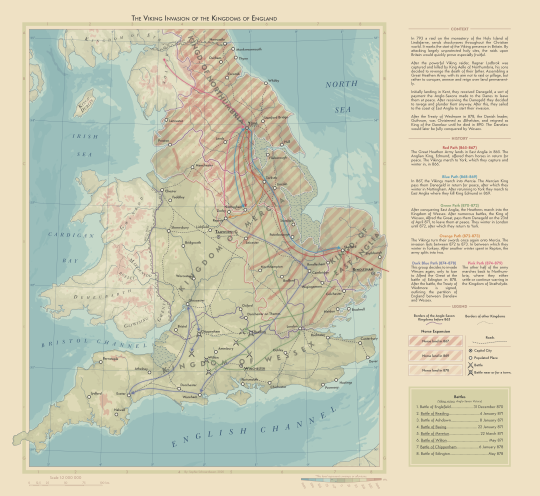
The Movements of the Great Heathen Army in England
In 793 a raid on the monastery of the Holy Island of Lindisfarne, sends shockwaves throughout the Christian world. It marks the start of the Viking presence in Britain. By attacking largely unprotected holy sites, the raids upon Britain would quickly prove especially fruitful.
After the powerful Viking raider, Ragnar Lodbrok was captured and killed by King Aelle of Northumbria, his sons decided to revenge the death of their father. Assembling a Great Heathen Army, with its aim not to raid or pillage, but rather to conquer, annexe and reign over land permanently.
Initially landing in Kent, they received Danegeld, a sort of payment the Anglo-Saxons made to the Danes to leave them at peace. After receiving the Danegeld they decided to ravage and plunder Kent anyway. After this, they sailed to the coast of East Anglia to start their invasion.
After the Treaty of Wedmore in 878, the Danish leader, Guthrum, was Christened as Æthelstan, and reigned as King of the Danelaw until he died in 890. The Danelaw would later be fully conquered by Wessex.
146 notes
·
View notes
Note
FMK: Ubba, Guthrum, Haesten
How very DARE you. Cursed ask gets a curse answer.
Fuck Ubba. He’s the only character to canonically have had a threesome (even tho it looked a little weird?). I can’t help myself, I’m a sucker for very tall men.
Marry Guthrum. He has lovely hair and wants to learn and knows how to be a good politician and get what he wants. He becomes the king of East Anglia (which isn’t the best kingdom but hey, it’s a kingdom) and I wouldn’t mind being queen.
Kill Haesten. While I appreciate his overall aesthetic and his hot goss, he’s a snake and a coward on top of bein kinda rapey soooo yeah he’s gotta goooo
6 notes
·
View notes
Text

Will do a better mood board eventually but face claims for my first Danelaw Saga book.
It’s a quartet of original stories that occur following Guthrum’s conversion to Christianity when the Danes settle in East Anglia.
Book One focuses on Baldur and Eostre; who marry out of necessity to protect the fragile peace between the English and the Danes of East Anglia. Eostre expects the heathen husband her mother warns her about, while Baldur expects a fragile, timid wife in his English bride. How wrong they both were.
1 note
·
View note
Text
This week in Royal History 👑
.
Between 6 & 12 May 878
.
Alfred the Great defeats the 'Great Heathen army led by Viking warlord Guthrum at the Battle of Edington resulting in the Treaty of Wedmore later the same year.
.
Primary sources locate the battle at "Ethandun" or "Ethandune", & until a scholarly consensus linked its location with the present-day Edington in Wiltshire it was known as the Battle of Ethandun, a name which continues to be used.
.
Prior to Battle;
.
In 865/66 a 'Great Heathen Army' invaded. It was said to have been under the leadership of the brothers Ivar the Boneless, Ubba, & Halfdan Ragnarsson, sons of Ragnar Lodbrok as named in the Norse sagas.
.
By 870, the 'Northmen' had conquered the kingdoms of Northumbria & East Anglia, & in 871 they attacked Wessex. Of the nine battles mentioned by the Anglo-Saxon Chronicle during that year, only one was a West Saxon victory; but in this year Alfred the Great succeeded his brother Ethelred, who died after the Battle of Merton.
.
Mercia had collapsed by 874. Halfdan Ragnarsson went back to Northumbria & fought the Picts & the Strathclyde Welsh. His army settled there & he is not mentioned after 876. Guthrum, with two other unnamed kings, made several attacks on Wessex, starting in 875, & in the last nearly captured Alfred at Chippenham. By 878, the Danes held the east & northeast of England, & their defeat at the Battle of Ashdown had paused but not halted their advance. Alfred the Great had spent the winter preceding the Battle of Edington in the Somerset marsh of Athelney, the nature of the country giving him some protection. In the spring of 878, he summoned his West Saxon forces & marched to Edington, where he met the Danes, led by Guthrum, in battle.
.
.
The Battle,
.
Possibly between 4 & 7 May, Alfred called a levy at Ecgbryhtesstan (Egbert's Stone) Many of the men in the counties around (Somerset, Wiltshire, & Hampshire) who had not already fled rallied to him there.
.
At Ethandun, on an unknown date between 6 & 12 May, they fought the Danes.
.
"Fighting ferociously, forming a dense shield-wall against the whole army of the Pagans, & striving long & bravely...at last he [Alfred] gained the victory. He overthrew the Pagans with great slaughter, & smiting the fugitives, he pursued them as far as the fortress."
.
After the victory, when the Danes had taken refuge in the fortress, the West Saxons removed all food that the Danes might be able to capture in a sortie, & waited. After two weeks, the hungry Danes sued for peace, giving Alfred "preliminary hostages & solemn oaths that they would leave his kingdom immediately", just as usual, but in addition promising that Guthrum would be baptized. Alfred had decisively defeated the Danes at Edington, rather than just stopping them as before, & therefore it seemed more likely that they would keep to the terms of the treaty.
.
The primary reason for Alfred's victory was probably the relative size of the two armies. The men of even one shire could be a formidable fighting force, as those of Devon proved in the same year, defeating an army under Ubbe Ragnarsson at the Battle of Cynwit. In addition, in 875 Guthrum had lost the support of other Danish lords, including Ivar & Ubba.
Post Battle;
Three weeks after the battle, Guthrum was baptized in Somerset with Alfred as his sponsor. It is possible that the enforced conversion was an attempt by Alfred to lock Guthrum into a Christian code of ethics, hoping it would ensure the Danes' compliance with any treaties agreed to. The converted Guthrum took the baptismal name of Athelstan.
.
Under the terms of the Treaty of Wedmore, the converted Guthrum was required to leave Wessex & return to East Anglia. Consequently, in 879 the Viking army left Chippenham & made its way to Cirencester & remained there for a year. The following year the army went to East Anglia, where it settled.
.
Also in 879, according to Asser, another Viking army sailed up the River Thames wintered at Fulham. Over the next few years this particular Danish faction had several encounters with Alfred's forces. However, Alfred managed to contain this threat by reforming his military & setting up a system of fortified cities, known as burghs or burhs.
.
In 886, the Treaty of Alfred & Guthrum defined the boundaries of their two kingdoms. The kingdom of Mercia was divided up, with part going to Alfred's Wessex & the other part to Guthrum's East Anglia. The agreement also defined the social classes of Danish East Anglia & their equivalents in Wessex. It tried to provide a framework that would minimize conflict & regulate commerce between the two peoples. It is not clear how seriously Guthrum took his conversion to Christianity, but he was the first of the Danish rulers of the English kingdoms to mint coins on the Alfredian model, under his baptismal name.
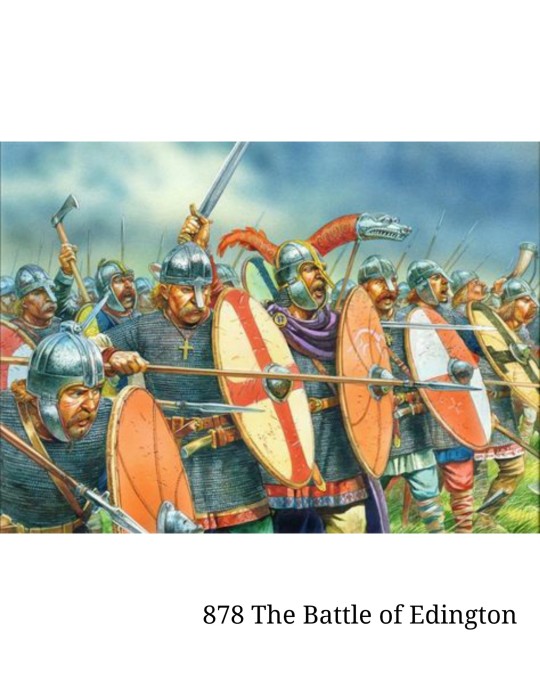
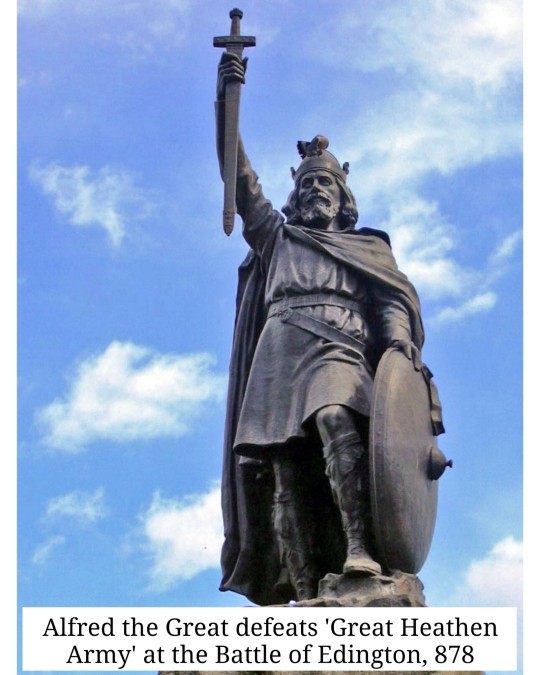
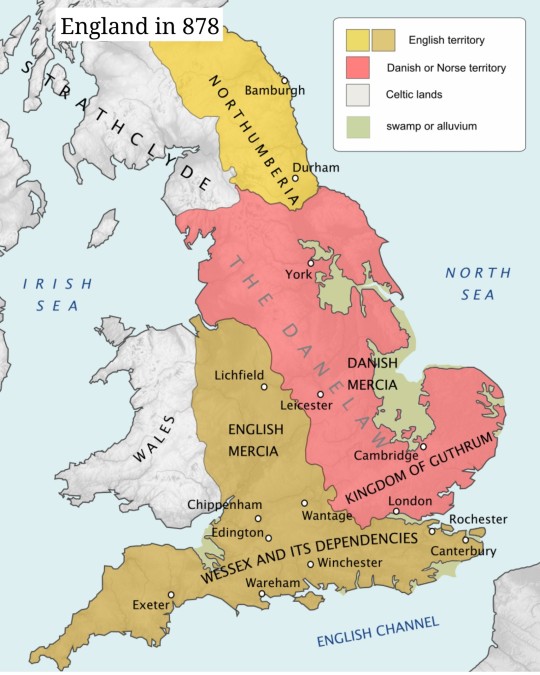
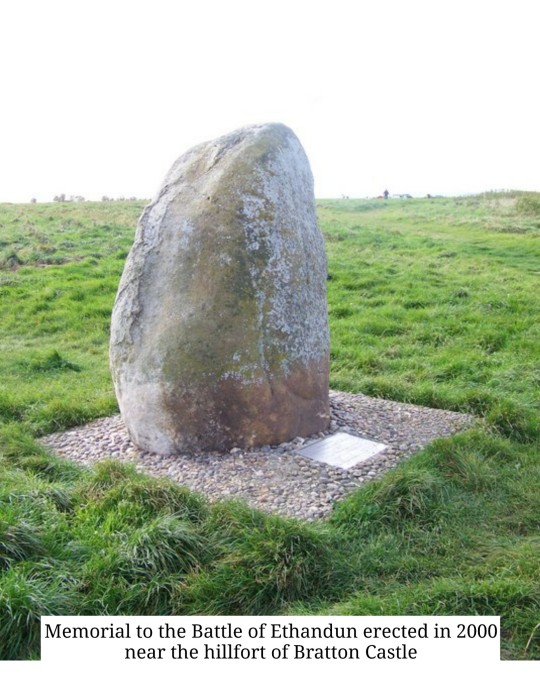
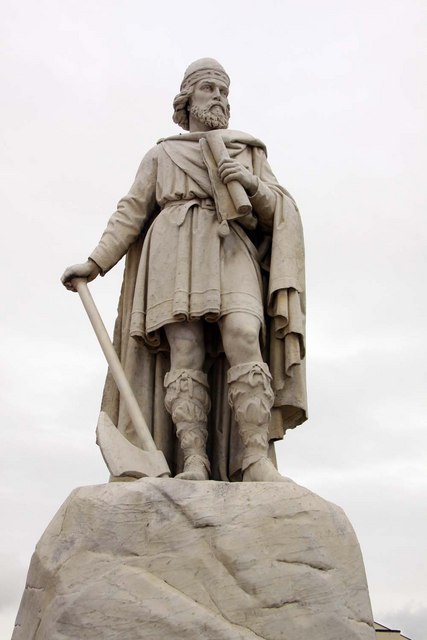

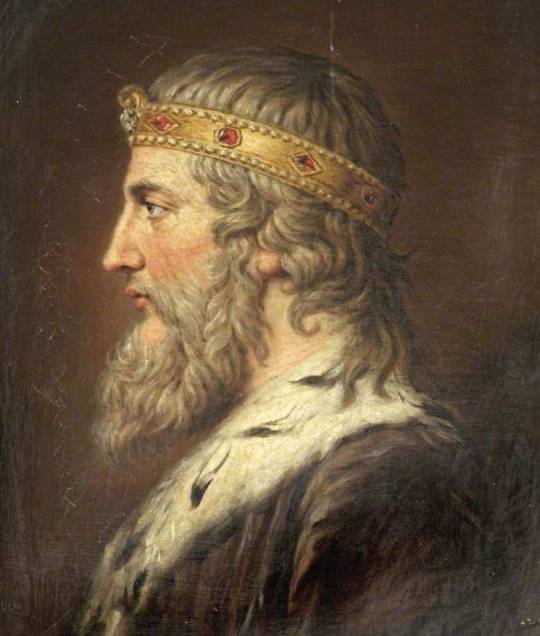
#monarchy#royal#Wessex#alfred the great#alfredthegreat#king alfred#historic#history#EDINGTON#anglosaxon#anglosaxons#anglo saxons#anglo saxon#vikings#the vikings#GUTHRUM
12 notes
·
View notes
Text
Wessex Campaign
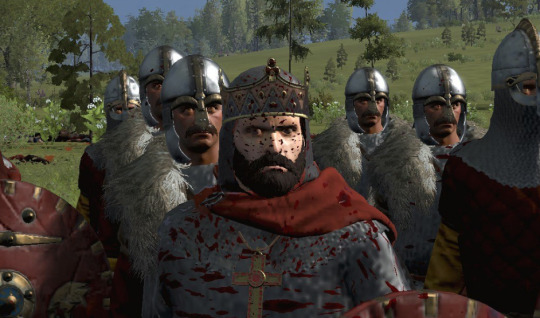
So I thought I’d run a new Thrones of Britannia campaign, this time playing as Wessex for the first time. And since I’m between fiction and procrastinating from the PhD, why not write up my adventures? Below the cut is the story of Alfred’s Wessex as it unfolds, on a PC in Edinburgh, Scotland, in the early weeks of the Year of Our Lord 2019.
Wessex, 878 AD.
The kingdom of Wessex stands in a precarious position. Its king, Alfred, has been ruling for seven years. Most of the Saxon kingdoms south of Alba and east of the lands of the Britons are occupied by Danish invaders – chiefly the Vikings of Northyumbre and East Anglia. The latter is ruled by the opportunistic Guthrum, a Danish warlord who has converted to Christianity as part of the Treaty of Wedmore, signed after being defeated by Alfred mere weeks ago, at the battle of Edington. For now, there is peace.
It will not last.
Alfred, ever-mindful of his dream of creating a united England capable of resisting Scandinavian invasion, sends emissaries to the three remaining independent Saxon kingdoms – Mercia, Westmoringas and Northleode. Along with gifts of coin from the former and the latter (600 and 500 pieces of silver respectively), all three kingdoms agree to mutual declarations of friendship.
The seeds of future alliances thus planted, Alfred sets about securing his own kingdom’s stability, specifically seeking the loyalty of the powerful thanes and ealdormen that rule his shires. The two most rebellious noblemen are Wiglaf, governor of Dorset, and Hrotheweard, governor of Dorchester. To the first, Alfred betroths his older sister, Aethelswith, whose strictness helped to secure his loyalty. The latter, Alfred raises to the rank of King’s Captain, hoping such an honour will ensure his allegiance.
The lands of Wessex were rich and fertile, and royal taxes were put to use that spring and summer – in Somerset cattle grazing pastures are cleared and silver mines dug, while in Wiltun a notable potter’s workshop was founded.
Alfred also sends an emissary to Guthrum, seeking a declaration of friendship in the aftermath of the Treaty of Wedmore, seeking confirmation that the terms are being respected. Guthrum refuses to meet with Alfred’s messanger..
Chill spring mornings give way to lazy summer days, and it becomes clear that Ealdorman Hrotheweard’s disloyalty runs deeper than any had suspected. Not only does he abandon his governorship of Dorchester and declare himself in open rebellion against Alfred, but he convinces another powerful theng, Aelfwald, and half of his fyrd to declare for him. A little-known noble, Wulfsige, rallies the remains of the fyrd still loyal to Alfred and leads them to the village of Cissanbyrig, where he receives reinforcements and Alfred’s private thanks. Alfred’s own fyrd begins to march for Cissanbyrig, and the title of King’s Captain is stripped from Hrotheweard in absentia and granted to Beorhtric, governor of Summerset.
Aelfwald and a third of the rebelling forces attack Wulfsige and the loyalists at Cissanbyrig, but are driven off. The prisoners are treated as rebels, and executed. Aelfwald is hunted down and killed. Although Hrotheweard, Dorchester’s governor, was now the clear head of the rebellion, the burgh itself has refuses to join him and closes its gates against his men.
As the snows closed in Wulfsige marches with reinforcements to Dorchester, while Hrotheweard retreats north into Merica. Despite the winter weather, more agricultural projects are carried out on the king’s orders – communal fields have been cleared around Ethandun and Cissanbyrig in preparation for spring planting, making the area Wessex’s breadbasket.
879 AD. Saxons United.
The new year brings with it rumours of Viking longships spotted off the east coast of Kent. Hrotheweard and most of his rebel army meet a grim fate – a trio of minor Danish lords, those of Bedeborg, Heimiliborg and Ledborg, had all declared war on Merica and are seizing their eastern shires. The rebels find themselves in the way of Bedeborg’s host – Hrotheweard is killed and the survivors forced to flee south once more, preferring the mercy of their countrymen to the fury of the Danes. They don’t find any. Alfred personally oversees their execution, and the governorship of Dorchester is granted to a thane named Ealhwine. To help secure his loyalty, Alfred grants one of his estates at Cissanbyrig to him.
To the north, the situation is rapidly deteriorating. Mercia is beset not only by a flurry of attacks from Danish kingdoms to the east, but also by the Britons from the west. Understanding that his realm is months from total collapse, King Ceolwulf of Mercia agrees to submit to Alfred – Mercia will formally become a vassal kingdom of Wessex and will provide 1,300 pieces of silver immediately. In exchange Wessex will guarantee Mercia’s protection, and will wage war against the Danes of Bedeborg.

The treaty is Alfred’s first step to a united England. Not wishing to find themselves at war with two Saxon kingdoms rather than just one, the Britons agree to cease their raiding against Merica, while both Heimiliborg and Ledeborg refuse to support Bedeborg any longer in their new war with Wessex. Alfred acts immediately, dispatching Wulfsige to seize Buckingham with the greater part of the fyrd of Wessex.
Catching the Danes off guard with a march in winter conditions, the remains of the Wessex fyrd under Alfred’s personal command then seizes Oxford and unites with Wulfsige’s fyrd.
880 AD. War in the North.
A new year brings new difficulties among Alfred’s Earldomen. Leofstan, governor of Hamtunscir, makes a claim to one of the royal estates, declaring that his great-grandfather had rights to the land and that the inheritance should be his. Doubtless goaded by Leofstan’s grandstanding the governor of Wiltscir, Aelfric, making a similar claim to royal lands within his own shire. Alfred grants them to both men, in exchange for a total sum of 7,000 pieces of silver.
The war in the north of Wessex continues. With the melting of the snows, Alfred and Wulfsige’s combined fyrd attacks the Danes of the self-declared king of Bedeborg, Copsig, outside Buckingham. The Danes are crushed, Cospig is killed fighting a rearguard with his personal bodyguard, and the final Bedeborg hold at Bedanford submits to Alfred.
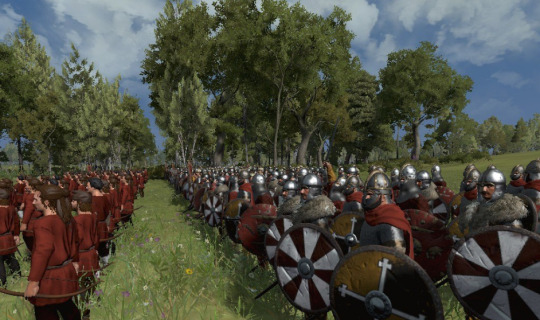
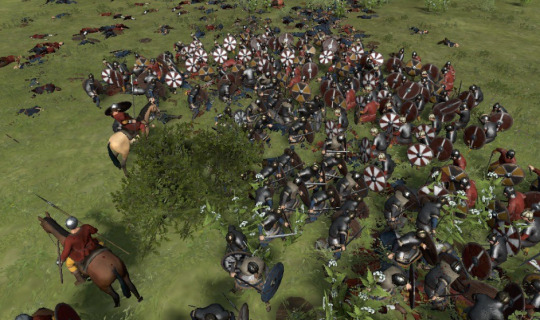
In thanks for the victory over the pagans of Bedeborg, that summer Alfred authorises the founding of two new Benedictine Abbeys in Summerset. Guthrum, again approached by Alfred’s emissaries, this time accepts a public declaration of friendship – the Danes have fallen out among themselves, as they are want to do, and Guthrum’s kingdom of East Anglia is now at war with the Vikings of Northleod. Peace between Wessex and East Anglia is in the interests of both Alfred and Gurthum. Buoyed by God’s obvious favour in the defeat of Bedeborg, Alfred eyes the smaller Danish fiefdoms further north.
That winter an opportunity presents itself. A feud between Anlaf, lord of the Danes of Hemiliborg, and Thored, lord of the Danes of Steinnborg, has devolved into open warfare. Another Danish jarl, Siward of the Veidrborg, has entered the conflict on Thored’s side. Sensing an opportunity, Alfred agreed to likewise join Thored, provided that any land taken by the fyrd of Wessex will be ceded to Alfred’s kingdom. Wulfsige and Alfred immediately marched north and lay siege to the walled burgh of Northampton, Anlaf’s main stronghold.
881 AD. The Storming of Northampton
News comes that Danish raiding in the north of Merica has devolved into all-out war – in a bid for power the Danish jarl, Haeric of Djurby, makes a drive into Merica’s northern shires, though the fighting there between Danes and Mercians proves inconclusive.
As the siege of Northampton continues Alfred receives word of more longship sightings, this time along the south coast. Unable to leave Wessex imperilled, he takes part of the fyrd and marches south, leaving Wulfsige to continue the siege.
That summer Wiglaf, governor of Dorset, comes to Alfred requesting further royal lands to practice his personal love of agriculture on. He is granted the estate at Sceaftesburg. Meanwhile, the great hall founded in the burgh of Winchester is completed.
Alfred arrives back in his capital at Winchester, preparing to raise the fyrd in the south of the kingdom to resist a fresh seaborne invasion. Mindful that the siege has already lasted months and that winter is fast approaching, Wulfsige leads an assault on Northampton’s walls. After fierce and bitter fighting, including Wulfsige personally leading his retinue and longaxemen through boiling oil, spears and javelins to storm the main gate to the town, the garrison is overcome and the Saxon inhabitants are liberated from the Danelaw.
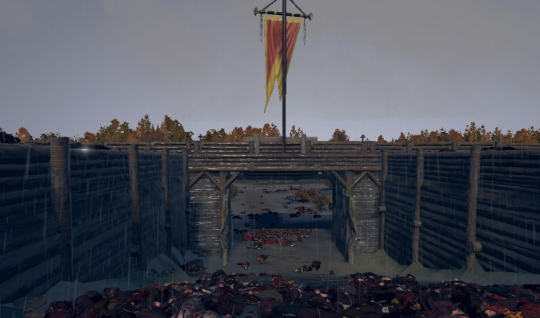
Alfred orders the construction of a church in the burgh to commemorate the victory, and gives over the new governorship to his nephew, Aethelhelm, son of his deceased older brother, Aethelred. Aethelhelm has only just come of age, and the governorship of Wessex’s new frontier will be a keen test of both his ability and his loyalty.
As winter approaches the Danes of Steinnborg and Veidrborg lay siege to the last warriors of Hemiliborg at the town of Steanford. Wulfsige’s fyrd winters in Northhampton, and word reaches Winchester that the Danes in East Anglia and Northymbre have finally ceased their feuding and signed a peace treaty – it may soon be that Guthrum and the Great Army of the Danes turns their attention west once again.
882 AD. Raiders Along the South Coast
As the weather improves Wulfsige leads the fyrd from their cantonments outside Northhampton and lays siege to Waerncwicum, the last fortified burgh in the west still controlled by Danes loyal to Hemiliborg. Steinnborg takes Steanford in the east, while Aethelhelm, settling into his role as governor of Northhampton, is granted a royal estate at Bedanford. Welcome news that Mercia’s fyrd had crushed the last of the Jarl Haeric’s Danes and seized his stronghold at Deoraby.
Ever the scholar, Alfred uses his time in Winchester to ratify the construction of a court school in the burgh. That summer the royal orchard at Oxford is also enlarged.
In July Wulfsige storms Waerncwicum, again personally leading the assault. While Leofric, inheritor of Jarl Anlaf, escapes, he and the last of the warriors still loyal to him are hunted down and killed, signalling the end of the petty kingdom of Hemiliborg.
Further south, news reaches Alfred that a Danish jarl known as Aemund of the Dragons of the Sea has landed his longships east of Seolesigge, on the south coast. Apparently not knowing that Alfred is in Winchester, the Danish raiders march inland and prepare to attack the royal burgh, only to be slaughtered outside the town walls by Alfred’s huscarls and those of the ealdorman of Winchester, Leofstan.
883 AD. Rebellion
In March the kingdom of Wessex rejoices – the queen has given birth to another son, Ecgric. Amidst the celebrations rumours abound that Ealhwine, theng on Dorchester, is plotting to have Alfred’s older sister Aethelswith killed after a feud with her husband.
Wulfsige returns from Waerncwicum and is feted as a hero in Winchester, while Alfred orders the founding of a Royal Hall in the burgh to further cement it as a great capital not only of Wessex, but of all of England.
With his plot apparently now public knowledge, Ealhwine makes his play that winter, refusing to answer the king’s summons to Winchester and then barring the gates of Dorchester in defiance of his officials. The rebel ealdorman then raids and burns Buckingham, using the loot and the apparent inability of Alfred to retaliate in order to attract more followers and legitimise his uprising.
884 AD. War with the Britons
As Alfred gathers the fyrd to oppose the rebel Ealhwine, news reaches Winchester that the Saxons of Dane-controlled Northymbre, supported by the independent Saxon kingdom of Northleode, have risen in rebellion against their Scandinavian masters. Whilst wishing to aid the north Saxons, Ealhwine’s rebellion focusses Alfred’s attention.
The King of Wessex does not immediately march to reclaim Dorchester, wanting instead to gather a show of strength that will ensure the rebellious shire never again tries his patience. Fyrdmen are summoned across the summer from all over Wessex and Kent. Alfred then marches with overwhelming force on Dorchester. The burgh surrenders and Ealhwine is beheaded in the market square. Governorship of the shire is granted to Aethelwold, Aethelheim’s younger brother, who has only recently come of age. Ealwine’s confiscated estates are granted to Aethelfrith, the new Saxon governor of South Mercia.
That winter, news comes that Wessex is not to enjoy a renewed peace in the wake of the rebellion’s defeat. Briton raiding in the west of Merica, aided an abetted by the Welsh kingdom of Powis, has become intolerable, and a Merica fyrd under ealdorman Ceolwulf has been mustered to march west and teach the Britons a lesson. Alfred pledges support for the venture, an act that causes the minor Briton kingdom of Gliwissig – until then a vassal of Wessex – to denounce Alfred’s authority and back the king of Powis. Wulfsige is once again given command of the fyrd of Wessex and they march west, crossing the River Severn into the kingdom of Gwent, which has refused to back Gliwissig’s rebellion.
885 AD. Into the West
Word of a battle outside the west Mercian town of Scrobbesburgh reaches Winchester – the Mercian fyrd under Ceolwulf have crushed the Britons of Powis. Wulfsige continues to march on Lann Ildult where the king of Gliwissig, Owen, holds court.
Alfred authorises the founding of a new nunnery in Winchester, as well as the enlargement of the church of Saint Swithun. It emerges that young Aethelwold, governor of Dorchester, has become infatuated with Wulfhilda, the daughter of a minor theng. Though the king’s nephew would be expected to marry more strategically, Wulfhilda’s beauty is legendry, and Alfred grants the couple his blessing.
Wulfsige arrives at Lann Ildult, only to find that the warriors of Gwent have beaten him to it - seemingly eager to prove their loyalty, the south-eastern Britons have stormed Owen’s stronghold and killed him. News also arrives from the north - the Briton kingdom of Gwined, perhaps threatened by Ceolwulf’s victory, have thrown their lot in with Powis and stormed the Mercian burgh of Chester.
WHAT FUTURE AWAITS ALFRED’S KINGDOM? TUNE IN WHEN I’VE PLAYED MORE!
44 notes
·
View notes
Video
youtube
The Danelaw - Alfred vs. Guthrum - Extra History - #1
The year is 865. Dragon ships push up on the shores of East Anglia. But this is no raid—it’s the Great Heathen Army. They’re not here for treasure. They’re here to found a nation.
Sponsored by Total War Saga: Thrones of Britannia! http://store.steampowered.com/app/712100/Total_War_Saga_Thrones_of_Britannia/
18 notes
·
View notes